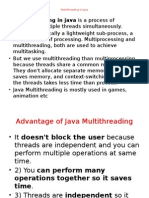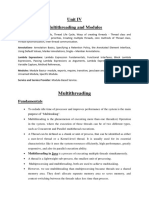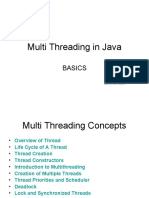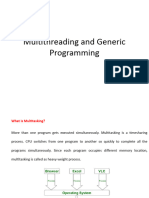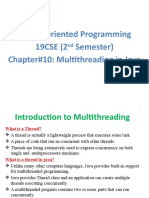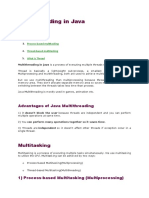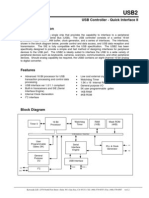Unit-5 Multithreading
Uploaded by
egadydqmdctlfzhnkbUnit-5 Multithreading
Uploaded by
egadydqmdctlfzhnkbGLS UNIVERSITY
SEM – III
0301301 - CORE JAVA
Dr. Disha Shah
Prof. Neha Vaswani
Index
Applets
Multi-threading
●
Introduction
●
Introduction ●
Applet class
●
Thread Life cycle ●
Applet Life cycle
●
Applet Structure
●
java.lang.Thread ●
Common methods
●
Main thread – drawString()
– setBackground()
●
Creation of New Thread – setForeground()
– showStatus()
– By inheriting Thread class ●
Applet using Graphic class
– By implementing Runnable – drawLine()
interface – setColor() and setFont()
– drawOval() and fillOval()
– Thread Priorities – drawRect() and fillRect()
Unit – 5
Multithreading in Java
Multithreading in Java
●
Multithreading in java is a process of executing multiple
threads simultaneously.
●
Thread is basically a lightweight sub-process, a smallest
unit of processing.
●
Multiprocessing and multithreading, both are used to achieve
multitasking.
●
But we use multithreading than multiprocessing because
threads share a common memory area.
●
They don't allocate separate memory area so saves memory,
and context-switching between the threads takes less time
than process.
●
Java Multithreading is mostly used in games, animation etc.
Multithreading in Java
Advantages of Java Multithreading
●
It doesn't block the user because threads are independent
and you can perform multiple operations at same time.
●
You can perform many operations together so it saves
time.
●
Threads are independent so it doesn't affect other threads
if exception occur in a single thread.
Multitasking
●
Multitasking is a process of executing multiple tasks
simultaneously. We use multitasking to utilize the CPU.
●
Multitasking can be achieved by two ways:
1) Process-based Multitasking (Multiprocessing)
2) Thread-based Multitasking (Multithreading)
Multitasking
1) Process-based Multitasking (Multiprocessing)
●
Each process have its own address in memory i.e. each process
allocates separate memory area.
●
Process is heavyweight.
●
Cost of communication between the process is high.
●
Switching from one process to another require some time for saving
and loading registers, memory maps, updating lists etc.
2) Thread-based Multitasking (Multithreading)
●
Threads share the same address space.
●
Thread is lightweight.
●
Cost of communication between the thread is low.
●
At least one process is required for each thread.
What is Thread in java?
●
A thread is a lightweight sub process, a smallest unit
of processing.
●
It is a separate path of execution.
●
Threads are independent, if there occurs exception in one
thread, it doesn't affect other threads.
●
It shares a common memory area.
●
At a time one thread is executed only.
What is Thread in java
Life cycle of a Thread (Thread States)
●
A thread can be in one of the five states.
●
The life cycle of the thread in java is controlled by JVM.
●
The java thread states are as follows:
– New
– Runnable
– Running
– Non-Runnable (Blocked)
– Terminated
Life cycle of a Thread
Life cycle of a Thread
Life cycle of a Thread
New: The thread is in new state if you create an instance
of Thread class but before the invocation of start() method.
Runnable: The thread is in runnable state after invocation
of start() method, but the thread scheduler has not
selected it to be the running thread.
Running: The thread is in running state if the thread
scheduler has selected it.
Non-Runnable (Blocked): This is the state when the thread
is still alive, but is currently not eligible to run.
Terminated: A thread is in terminated or dead state when
its run() method exits.
How to create thread
●
There are two ways to create a thread:
●
By extending Thread class
●
By implementing Runnable interface.
How to create thread
●
Thread class:
●
Thread class provide constructors and methods to create
and perform operations on a thread.
●
Thread class extends Object class and implements
Runnable interface.
●
Commonly used Constructors of Thread class:
Thread()
Thread(String name)
Thread(Runnable r)
Thread(Runnable r,String name)
Commonly used methods of Thread class:
●
public void run()
is used to perform action for a thread (entry point for a
thread).
●
public void start()
starts the execution of the thread. JVM calls the run()
method on the thread.
●
public void sleep(long miliseconds)
Causes the currently executing thread to sleep (temporarily
cease execution) for the specified number of milliseconds.
●
public void join(long miliseconds)
waits for a thread to die for the specified miliseconds.
Commonly used methods of Thread class:
●
public int getPriority()
returns the priority of the thread.
●
public int setPriority(int priority)
changes the priority of the thread.
●
public String getName()
returns the name of the thread.
●
public void setName(String name)
changes the name of the thread.
●
public Thread currentThread()
returns the reference of currently executing thread.
●
public int getId()
returns the id of the thread.
Commonly used methods of Thread class:
●
public Thread.State getState()
returns the state of the thread.
●
public boolean isAlive()
tests if the thread is alive.
●
public void yield()
causes the currently executing thread object to temporarily pause and allow
other threads to execute.
●
public void suspend()
is used to suspend the thread.
●
public void resume()
is used to resume the suspended thread.
●
public void stop()
is used to stop the thread.
Runnable interface:
●
The Runnable interface should be implemented by any
class whose instances are intended to be executed by a
thread.
●
Runnable interface have only one method named run().
public void run(): is used to perform action for a thread.
●
The most common use case of the Runnable interface is
when we want only to override the run method.
●
When a thread is started by the object of any class which
is implementing Runnable, then it invokes the run method
in the separately executing thread.
Runnable interface:
Steps to create a new Thread using Runnable :
1. Create a Runnable implementer and implement run() method.
2. Instantiate Thread class and pass the implementer to the
Thread, Thread has a constructor which accepts Runnable
instance.
3. Invoke start() of Thread instance, start internally calls run() of
the implementer. Invoking start(), creates a new Thread which
executes the code written in run().
Calling run() directly doesn’t create and start a new Thread, it will
run in the same thread. To start a new line of execution, call
start() on the thread.
Differences between Thread class and
Runnable interface
●
The significant differences between extending Thread
class and implementing Runnable interface:
●
When we extend Thread class, we can’t extend any other
class even we require and When we implement Runnable,
we can save a space for our class to extend any other
class in future or now.
●
When we extend Thread class, each of our thread creates
unique object and associate with it. When we implements
Runnable, it shares the same object to multiple threads.
Priority of a Thread (Thread Priority)
●
Each thread have a priority.
●
Priorities are represented by a number between 1 and 10.
●
In most cases, thread schedular schedules the threads according to their
priority.
●
But it is not guaranteed because it depends on JVM specification that
which scheduling it chooses.
●
3 constants defiend in Thread class:
●
public static int MIN_PRIORITY
●
public static int NORM_PRIORITY
●
public static int MAX_PRIORITY
●
Default priority of a thread is 5 (NORM_PRIORITY).
●
The value of MIN_PRIORITY is 1 and the value of MAX_PRIORITY is 10.
●
Thread1.java
●
Thread1_2.java
●
Thread1_3.java
●
Thread2.java
●
Thread2.java
●
Thread3.java
●
Thread3_1.java
●
Thread4.java
●
Thread5.java
●
Thread6.java
●
Thread61.java
You might also like
- Java Multithreading Interview Questions And AnswersFrom EverandJava Multithreading Interview Questions And AnswersNo ratings yet
- Unit - Iv Multithreading Multithreading in Java Is A Process of Executing Multiple Threads SimultaneouslyNo ratings yetUnit - Iv Multithreading Multithreading in Java Is A Process of Executing Multiple Threads Simultaneously43 pages
- Unit_3.1_MultiThreading.pptx_20250424_144710_0000No ratings yetUnit_3.1_MultiThreading.pptx_20250424_144710_000030 pages
- Chapter 4-Introduction To MultithreadingNo ratings yetChapter 4-Introduction To Multithreading13 pages
- 0b6at Wuxbp6ldWN1RWt6ZS1oWnZvbk5qTFYwdHVSSGxWYkV3No ratings yet0b6at Wuxbp6ldWN1RWt6ZS1oWnZvbk5qTFYwdHVSSGxWYkV340 pages
- Concurrent Programming in Java: Mrs. S.S.Jamsandekar Department of Computer Science Shivaji UniversityNo ratings yetConcurrent Programming in Java: Mrs. S.S.Jamsandekar Department of Computer Science Shivaji University27 pages
- E-Notes_790_Content_Document_20240917091004PMNo ratings yetE-Notes_790_Content_Document_20240917091004PM40 pages
- Module 1 Advanced Java Programming CSE3146 PPTsNo ratings yetModule 1 Advanced Java Programming CSE3146 PPTs33 pages
- By Asst. Professor Dept. of Computer Application ST - Joseph's College (Arts & Science) Kovur, ChennaiNo ratings yetBy Asst. Professor Dept. of Computer Application ST - Joseph's College (Arts & Science) Kovur, Chennai29 pages
- 20ES3102 Java Programming Unit III Chapter 3 Multithread ProgrammingNo ratings yet20ES3102 Java Programming Unit III Chapter 3 Multithread Programming17 pages
- 20CS6205 Fund. of JAVA Programming UNIT-IVNo ratings yet20CS6205 Fund. of JAVA Programming UNIT-IV28 pages
- (IJCST-V3I2P5) : Nikita Goel, Vijaya Laxmi, Ankur SaxenaNo ratings yet(IJCST-V3I2P5) : Nikita Goel, Vijaya Laxmi, Ankur Saxena8 pages
- Office of The Chief of Naval Operations 2000 Navy Pentagon WASHINGTON, DC 20350-2000No ratings yetOffice of The Chief of Naval Operations 2000 Navy Pentagon WASHINGTON, DC 20350-200011 pages
- Cuadernillo de Lenguaje Musical - 1º A by Pablo Dondarza - IssuuNo ratings yetCuadernillo de Lenguaje Musical - 1º A by Pablo Dondarza - Issuu3 pages
- Digital To Digital and Digital To Analog ConversionNo ratings yetDigital To Digital and Digital To Analog Conversion58 pages
- C27 Generator Set Electrical System: Dwb1-UpNo ratings yetC27 Generator Set Electrical System: Dwb1-Up2 pages
- CORDIS - Project ObsTrade Europe NeoliticNo ratings yetCORDIS - Project ObsTrade Europe Neolitic4 pages
- ClausePhrase - NounGerund - Verb - Er (Or) - Adj.-Noun - IzeNo ratings yetClausePhrase - NounGerund - Verb - Er (Or) - Adj.-Noun - Ize5 pages
- Microsoft Azure Enterprise DevOps Report 2020-2021100% (1)Microsoft Azure Enterprise DevOps Report 2020-202153 pages
- HSE Questionnaire - Construction Safety Notes - Aramco Download HSEO-Q 278 - (38-240) - Duplicate - Filter - A To Z100% (2)HSE Questionnaire - Construction Safety Notes - Aramco Download HSEO-Q 278 - (38-240) - Duplicate - Filter - A To Z16 pages
- Cryptocurrencies Are Disruptive Financial InnovatiNo ratings yetCryptocurrencies Are Disruptive Financial Innovati17 pages
- QP22EP1 - 290: Time: 3 Hours Total Marks: 100No ratings yetQP22EP1 - 290: Time: 3 Hours Total Marks: 1006 pages
- Excel 2007 Hyperlink To PDF Cannot Open The Specified FileNo ratings yetExcel 2007 Hyperlink To PDF Cannot Open The Specified File2 pages




























